Impact of Reverse Power Flow on Distributed Transformers in a Solar-Photovoltaic-Integrated Low-Voltage Network
Abstract
1. Introduction
- Transformer backflow limits due to high solar PV impacts;
- The maximum depth of penetration of solar PV at the margin of RPF in the substation transformer.
2. System Modelling and Power Flow Analysis
2.1. Equivalent Circuit of Inverter Grid Interphase
2.2. Solar PV Grid Load-Point Analysis
3. Materials and Methods
3.1. Case Study Network
3.2. Modelling of System Components
3.2.1. The 11 kV Source Feeder
3.2.2. Network Loads
3.2.3. Substation Transformer
3.2.4. Overhead Lines
3.2.5. Solar PV Dispersion Criteria
3.2.6. Algorithm for Solar PV Dispersion in LV Network
- Start;
- Run a load flow calculation for the LV network without a solar PV unit;
- Identify and place a solar PV unit at the load bus with the worst voltage profile;
- Run a load flow calculation for the network;
- Repeat steps 2 and 3 until transformer loadings (kW) register negative values;
- End.
4. Results and Discussions
4.1. Analysis of Transformer Operating Loads
4.1.1. Transformer kVA Loading
4.1.2. Transformer kW Loading
4.1.3. Transformer Percentage Loading
4.1.4. Transformer Load Losses
4.1.5. Transformer Load Current
4.1.6. Overloading of Distribution Transformers
4.2. Transformer Backflow and Overload Limits
5. Conclusions
Author Contributions
Funding
Data Availability Statement
Acknowledgments
Conflicts of Interest
References
- Kenneth, A.P.; Folly, K. Voltage Rise Issue with High Penetration of Grid Connected PV. IFAC Proc. Vol. 2014, 19, 4959–4966. [Google Scholar] [CrossRef]
- Dondariya, C.; Porwal, D.; Awasthi, A.; Shukla, A.K.; Sudhakar, K.; Murali, M.M.; Bhimte, A. Performance Simulation of Grid-Connected Rooftop Solar PV System for Small Households: A Case Study of Ujjain, India. Energy Rep. 2018, 4, 546–553. [Google Scholar] [CrossRef]
- Panigrahi, R.; Mishra, S.K.; Srivastava, S.C.; Srivastava, A.K.; Schulz, N.N. Grid Integration of Small-Scale Photovoltaic Systems in Secondary Distribution Network—A Review. IEEE Trans. Ind. Appl. 2020, 56, 3178–3195. [Google Scholar] [CrossRef]
- Chathurangi, D.; Jayatunga, U.; Perera, S.; Agalgaonkar, A.P.; Siyambalapitiya, T. A Nomographic Tool to Assess Solar PV Hosting Capacity Constrained by Voltage Rise in Low-Voltage Distribution Networks. Int. J. Electr. Power Energy Syst. 2022, 134, 107409. [Google Scholar] [CrossRef]
- Kadir, A.F.A.; Khatib, T.; Elmenreich, W. Integrating Photovoltaic Systems in Power System: Power Quality Impacts and Optimal Planning Challenges. Int. J. Photoenergy 2014, 2014, 321826. [Google Scholar]
- Ismael, S.M.; Aleem, S.H.E.A.; Abdelaziz, A.Y.; Zobaa, A.F. Probabilistic Hosting Capacity Enhancement in Non-Sinusoidal Power Distribution Systems Using a Hybrid PSOGSA Optimization Algorithm. Energies 2019, 12, 1018. [Google Scholar] [CrossRef]
- Holguin, J.P.; Rodriguez, D.C.; Ramos, G. Reverse Power Flow (RPF) Detection and Impact on Protection Coordination of Distribution Systems. IEEE Trans. Ind. Appl. 2020, 56, 2393–2401. [Google Scholar] [CrossRef]
- Saad, S.N.M.; van der Weijde, A.H. Evaluating the Potential of Hosting Capacity Enhancement Using Integrated Grid Planning Modeling Methods. Energies 2019, 12, 3610. [Google Scholar] [CrossRef]
- Afonaa-Mensah, S.; Wang, Q.; Uzoejinwa, B.B. Investigation of Daytime Peak Loads to Improve the Power Generation Costs of Solar-Integrated Power Systems. Int. J. Photoenergy 2019, 2019, 5986874. [Google Scholar] [CrossRef]
- Cohen, M.A.; Callaway, D.S. Effects of Distributed PV Generation on California’s Distribution System, Part 1: Engineering Simulations. Sol. Energy 2016, 128, 126–138. [Google Scholar] [CrossRef]
- Agah, S.M.M.; Abyaneh, H.A. Quantification of the Distribution Transformer Life Extension Value of Distributed Generation. IEEE Trans. Power Deliv. 2011, 26, 1820–1828. [Google Scholar] [CrossRef]
- Von Appen, J.; Braun, M.; Stetz, T.; Diwold, K.; Geibel, D. Time in the sun: The challenge of high PV penetration in the German electric grid. IEEE Power Energy Mag. 2013, 11, 55–64. [Google Scholar] [CrossRef]
- Jahangiri, P.; Aliprantis, D.C. Distributed Volt/VAr Control by PV Inverters. IEEE Trans. Power Syst. 2013, 28, 3429–3439. [Google Scholar] [CrossRef]
- Ameur, A.; Berrada, A.; Loudiyi, K.; Aggour, M. Analysis of Renewable Energy Integration into the Transmission Network. Electr. J. 2019, 32, 106676. [Google Scholar] [CrossRef]
- Mulenga, E.; Bollen, M.H.J.; Etherden, N. Distribution Networks Measured Background Voltage Variations, Probability Distributions Characterization and Solar PV Hosting Capacity Estimations. Electr. Power Syst. Res. 2021, 192, 106979. [Google Scholar] [CrossRef]
- Ebe, F.; Idlbi, B.; Morris, J.; Heilscher, G.; Meier, F. Evaluation of PV Hosting Capacities of Distribution Grids with Utilisation of Solar Roof Potential Analyses. CIRED—Open Access Proceedings Journal 2017, 2017, 2265–2269. [Google Scholar] [CrossRef]
- Sharma, V.; Aziz, S.M.; Haque, M.H.; Kauschke, T. Effects of High Solar Photovoltaic Penetration on Distribution Feeders and the Economic Impact. Renew. Sustain. Energy Rev. 2020, 131, 110021. [Google Scholar] [CrossRef]
- Guo, Y.; Wu, Q.; Gao, H.; Shen, F. Distributed Voltage Regulation of Smart Distribution Networks: Consensus-Based Information Synchronization and Distributed Model Predictive Control Scheme. Int. J. Electr. Power Energy Syst. 2019, 111, 58–65. [Google Scholar] [CrossRef]
- Daher, N.A.; Saliba, L.; Mougharbel, I.; Kanaan, H.Y.; Saad, M. Hybrid Algorithm for Monitoring Reverse Power Flow & Ause G E\Distributed Renewable Energy Sources. In Proceedings of the 2020 5th International Conference on Renewable Energies for Developing Countries (REDEC), Marrakech, Morocco, 29–30 June 2020; Volume 5, pp. 8–11. [Google Scholar]
- Torres, I.C.; Negreiros, G.F.; Tiba, C. Theoretical and Experimental Study to Determine Voltage Violation, Reverse Electric Current and Losses in Prosumers Connected to Low-Voltage Power Grid. Energies 2019, 12, 4568. [Google Scholar] [CrossRef]
- Aziz, T.; Ketjoy, N. PV Penetration Limits in Low Voltage Networks and Voltage Variations. IEEE Access 2017, 5, 16784–16792. [Google Scholar] [CrossRef]
- Hajeforosh, S.F.; Khatun, A.; Bollen, M. Enhancing the Hosting Capacity of Distribution Transformers for Using Dynamic Component Rating. Int. J. Electr. Power Energy Syst. 2022, 142, 108130. [Google Scholar] [CrossRef]
- Awadallah, M.A.; Xu, T.; Venkatesh, B.; Member, S.; Singh, B.N. On the Effects of Solar Panels on Distribution Transformers. IEEE Trans. Power Deliv. 2016, 31, 1176–1185. [Google Scholar] [CrossRef]
- Wang, X.; Dsouza, K.; Tang, W.; Baran, M. Assessing the Impact of High Penetration PV on the Power Transformer Loss of Life on a Distribution System. In Proceedings of the 2021 IEEE PES Innovative Smart Grid Technologies Europe (ISGT Europe), Espoo, Finland, 18–21 October 2021; pp. 8–12. [Google Scholar] [CrossRef]
- Upadhyay, P.; Kern, J.; Vadlamani, V. Distributed Energy Resources (Ders): Impact of Reverse Power Flow on Transformer. CIGRE Sci. Eng. 2020, 19, 99–107. [Google Scholar]
- Manito, A.R.A.; Pinto, A.; Zilles, R. Evaluation of Utility Transformers’ Lifespan with Different Levels of Grid-Connected Photovoltaic Systems Penetration. Renew. Energy 2016, 96, 700–714. [Google Scholar] [CrossRef]
- Affonso, C.D.M.; Kezunovic, M. Technical and Economic Impact of Pv-Bess Charging Station on Transformer Life: A Case Study. IEEE Trans. Smart Grid 2019, 10, 4683–4692. [Google Scholar] [CrossRef]
- Novoa, L.; Flores, R.; Brouwer, J. Optimal Renewable Generation and Battery Storage Sizing and Siting Considering Local Transformer Limits. Appl. Energy 2019, 256, 113926. [Google Scholar] [CrossRef]
- Rafael, F.; Sevilla, S.; Knazkins, V.; Korba, P.; Kienzle, F. Limiting Transformer Overload on Distribution Systems with High Penetration Limiting Transformer Overload on Distribution Systems with High Penetration of PV Using Energy Storage Systems. Int. J. Emerg. Technol. Adv. Eng. 2016, 6, 294–303. [Google Scholar]
- De Carne, G.; Buticchi, G.; Zou, Z.; Liserre, M. Reverse Power Flow Control in a ST-Fed Distribution Grid. IEEE Trans. Smart Grid 2018, 9, 3811–3819. [Google Scholar] [CrossRef]
- Baroni, B.R.; Uturbey, W.; Costa, A.M.G.; Rocha, S.P. Impact of Photovoltaic Generation on the Allowed Revenue of the Utilities Considering the Lifespan of Transformers: A Brazilian Case Study. Electr. Power Syst. Res. 2021, 192, 106906. [Google Scholar] [CrossRef]
- Uçar, B.; Bağrıyanık, M.; Kömürgöz, G. Influence of PV Penetration on Distribution Transformer Aging. J. Clean Energy Technol. 2017, 5, 131–134. [Google Scholar] [CrossRef]
- El Batawy, S.A.; Morsi, W.G. On the Impact of High Penetration of Rooftop Solar Photovoltaics on the Aging of Distribution Transformers. Can. J. Electr. Comput. Eng. 2017, 40, 93–100. [Google Scholar] [CrossRef]
- Pezeshki, H.; Wolfs, P.J.; Ledwich, G. Impact of High PV Penetration on Distribution Transformer Insulation Life. IEEE Trans. Power Deliv. 2014, 29, 1212–1220. [Google Scholar] [CrossRef]
- Pollock, J.; Hill, D. Overcoming the Issues Associated with Operating a Distribution System in Reverse Power Flow. IET Conf. Publ. 2016, 2016, 2–7. [Google Scholar] [CrossRef]
- Liu, H.; Guo, Y.; Ge, S.; Zhao, M. Impact of DG Configuration on Maximum Use of Load Supply Capability in Distribution Power Systems. J. Appl. Math. 2014, 2014, 136726. [Google Scholar] [CrossRef]
- Anto, E.K.; Frimpong, E.A.; Okyere, P.Y. Impact Assessment of Increasing Solar PV Penetrations on Voltage and Total Harmonic Distortion of a Distribution Network. J. Multidiscip. Eng. Sci. Stud. 2015, 1, 116–127. [Google Scholar]
- Obeng, M.; Gyam, S.; Sarfo, N.; Kabo-bah, A.T. Technical and Economic Feasibility of a 50 MW Grid-Connected Solar PV at UENR Nsoatre Campus. J. Clean Prod. 2020, 247, 119159. [Google Scholar] [CrossRef]
- Kwofie, E.A.; Mensah, G.; Anto, E.K. Determination of the Optimal Power Factor at Which DG PV Should Be Operated. In Proceedings of the 2017 IEEE PES PowerAfrica, Accra, Ghana, 27–30 June 2017; pp. 391–395. [Google Scholar]
- Kwofie, E.A.; Mensah, G.; Antwi, V.S. Post Commission Grid Impact Assessment of a 20 MWp Solar PV Grid Connected System on the ECG 33 KV Network in Winneba. In Proceedings of the IEEE PES/IAS PowerAfrica Conference: Power Economics and Energy Innovation in Africa, PowerAfrica 2019, Abuja, Nigeria, 20–23 August 2019; pp. 521–526. [Google Scholar]
- Paghdar, S.; Sipai, U.; Ambasana, K.; Chauhan, P.J. Active and Reactive Power Control of Grid Connected Distributed Generation System. In Proceedings of the 2017 Second International Conference on Electrical, Computer and Communication Technologies (ICECCT), Coimbatore, India, 22–24 February 2017; pp. 1–7. [Google Scholar] [CrossRef]
- Sadeghian, H.; Athari, M.H.; Wang, Z. Optimized Solar Photovoltaic Generation in a Real Local Distribution Network. In Proceedings of the 2017 IEEE Power and Energy Society Innovative Smart Grid Technologies Conference, ISGT 2017, Washington, DC, USA, 23–26 April 2017; pp. 1–5. [Google Scholar]
- Alsafasfeh, Q.; Saraereh, O.A.; Khan, I.; Kim, S. Solar PV Grid Power Flow Analysis. Sustainability 2019, 11, 1744. [Google Scholar] [CrossRef]
- Gnanadass, B.M.R. Solar Integrated Time Series Load Flow Analysis for Practical Distribution System. J. Inst. Eng. Ser. B 2021, 102, 829–841. [Google Scholar] [CrossRef]
- Vinayagam, A.; Aziz, A.; PM, B.; Chandran, J.; Veerasamy, V.; Gargoom, A. Harmonics Assessment and Mitigation in a Photovoltaic Integrated Network. Sustain. Energy Grids Netw. 2019, 20, 100264. [Google Scholar] [CrossRef]
- Thomson, M.; Infield, D.G. Impact of Widespread Photovoltaics Generation on Distribution Systems. IET Renew. Power Gener. 2007, 1, 33–40. [Google Scholar] [CrossRef]
- Zain, M.; Ellabban, O.; Refaat, S.S.; Abu-rub, H.; Al-fagih, L. A Novel Methodology to Determine the Maximum PV Penetration in Distribution Networks. In Proceedings of the 2019 2nd International Conference on Smart Grid and Renewable Energy (SGRE), Doha, Qatar, 19–21 November 2019; pp. 1–6. [Google Scholar] [CrossRef]
- Kirui, K.P.; Murage, D.K.; Kihato, P.K. Fuse-Fuse Protection Scheme ETAP Model for IEEE 13 Node Radial Test Distribution Feeder. Eur. J. Eng. Res. Sci. 2019, 4, 224–234. [Google Scholar] [CrossRef]
- Setiawan, A.; Qashtalani, H.; Pranadi, A.D.; Ali, F.C.; Setiawan, E.A. Determination of Optimal PV Locations and Capacity in Radial Distribution System to Reduce Power Losses. Energy Procedia 2019, 156, 384–390. [Google Scholar] [CrossRef]
- Broderick, R.; Williaams, J.; Munoz-Ramos, K. Clustering Methods and Feeder Selection for PV System Impact Analysis. Available online: https://www.epri.com/research/products/000000003002002562 (accessed on 28 June 2022).
- Al-Saadi, H.; Zivanovic, R.; Al-Sarawi, S.F. Probabilistic Hosting Capacity for Active Distribution Networks. IEEE Trans. Ind. Inform. 2017, 13, 2519–2532. [Google Scholar] [CrossRef]
- Hoke, A.; Butler, R.; Hambrick, J.; Kroposki, B. Steady-State Analysis of Maximum Photovoltaic Penetration Levels on Typical Distribution Feeders. IEEE Trans. Sustain. Energy 2013, 4, 350–357. [Google Scholar] [CrossRef]
- Tsamaase, K.; Moyo, U.; Zibani, I.; Ngebani, I.; Mahindroo, P. Approximate Mathematical Model for Load Profiling and Demand Forecasting. IOSR J. Electr. Electron. Eng. (IOSR-JEEE) 2017, 12, 29–34. [Google Scholar] [CrossRef]
- Li, X.; Borsche, T.; Andersson, G. PV Integration in Low-Voltage Feeders with Demand Response. In Proceedings of the 2015 IEEE Eindhoven PowerTech, Eindhoven, The Netherlands, 29 June–2 July 2015. [Google Scholar] [CrossRef]
- Khan, M.A.; Arbab, N.; Huma, Z. Voltage Profile and Stability Analysis for High Penetration Solar Photovoltaics. Int. J. Eng. Work. 2018, 5, 109–114. [Google Scholar]
- Korab, R.; Połomski, M.; Smołka, M. Evaluating the Risk of Exceeding the Normal Operating Conditions of a Low-Voltage Distribution Network Due to Photovoltaic Generation. Energies 2022, 15, 1969. [Google Scholar] [CrossRef]
- Datta, U.; Kalam, A.; Shi, J. Smart Control of BESS in PV Integrated EV Charging Station for Reducing Transformer Overloading and Providing Battery-to-Grid Service. J. Energy Storage 2020, 28, 101224. [Google Scholar] [CrossRef]
- Raouf Mohamed, A.A.; Best, R.J.; John Morrow, D.; Cupples, A.; Bailie, I. Impact of the Deployment of Solar Photovoltaic and Electrical Vehicle on the Low Voltage Unbalanced Networks and the Role of Battery Energy Storage Systems. J. Energy Storage 2021, 42, 102975. [Google Scholar] [CrossRef]
- Yaghoobi, J.; Alduraibi, A.; Martin, D.; Zare, F.; Eghbal, D.; Memisevic, R. Impact of High-Frequency Harmonics (0–9 KHz) Generated by Grid-Connected Inverters on Distribution Transformers. Int. J. Electr. Power Energy Syst. 2020, 122, 106177. [Google Scholar] [CrossRef]


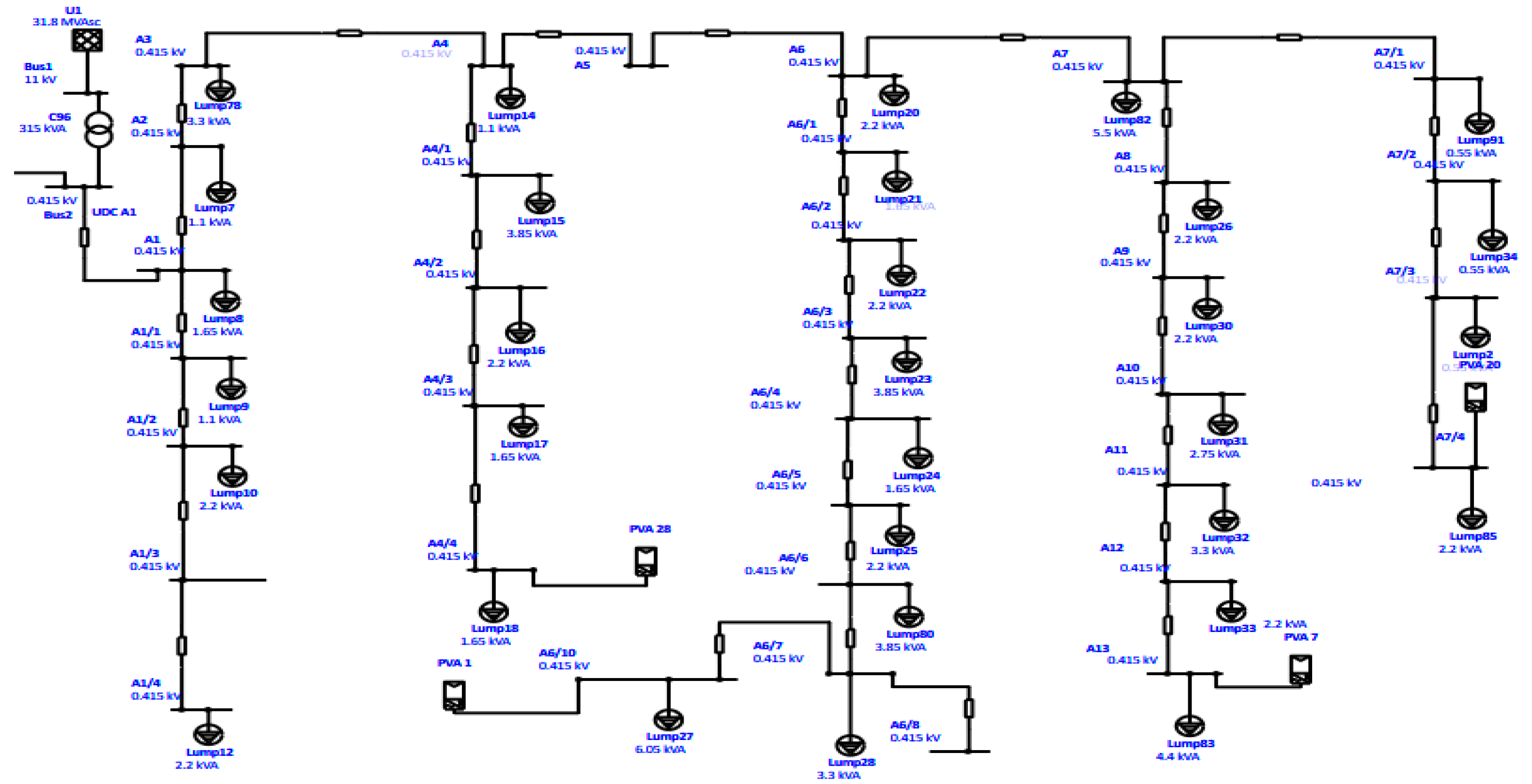
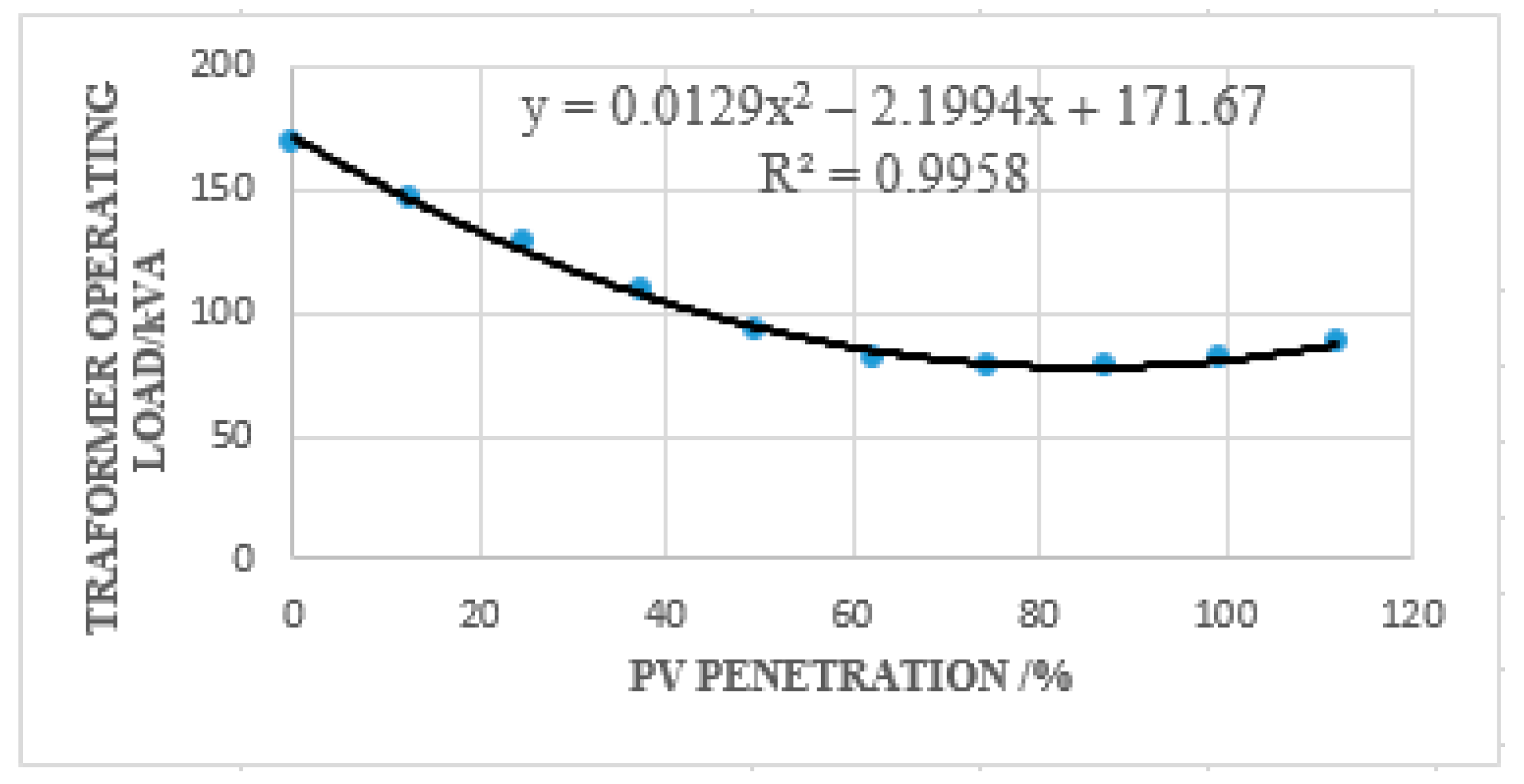
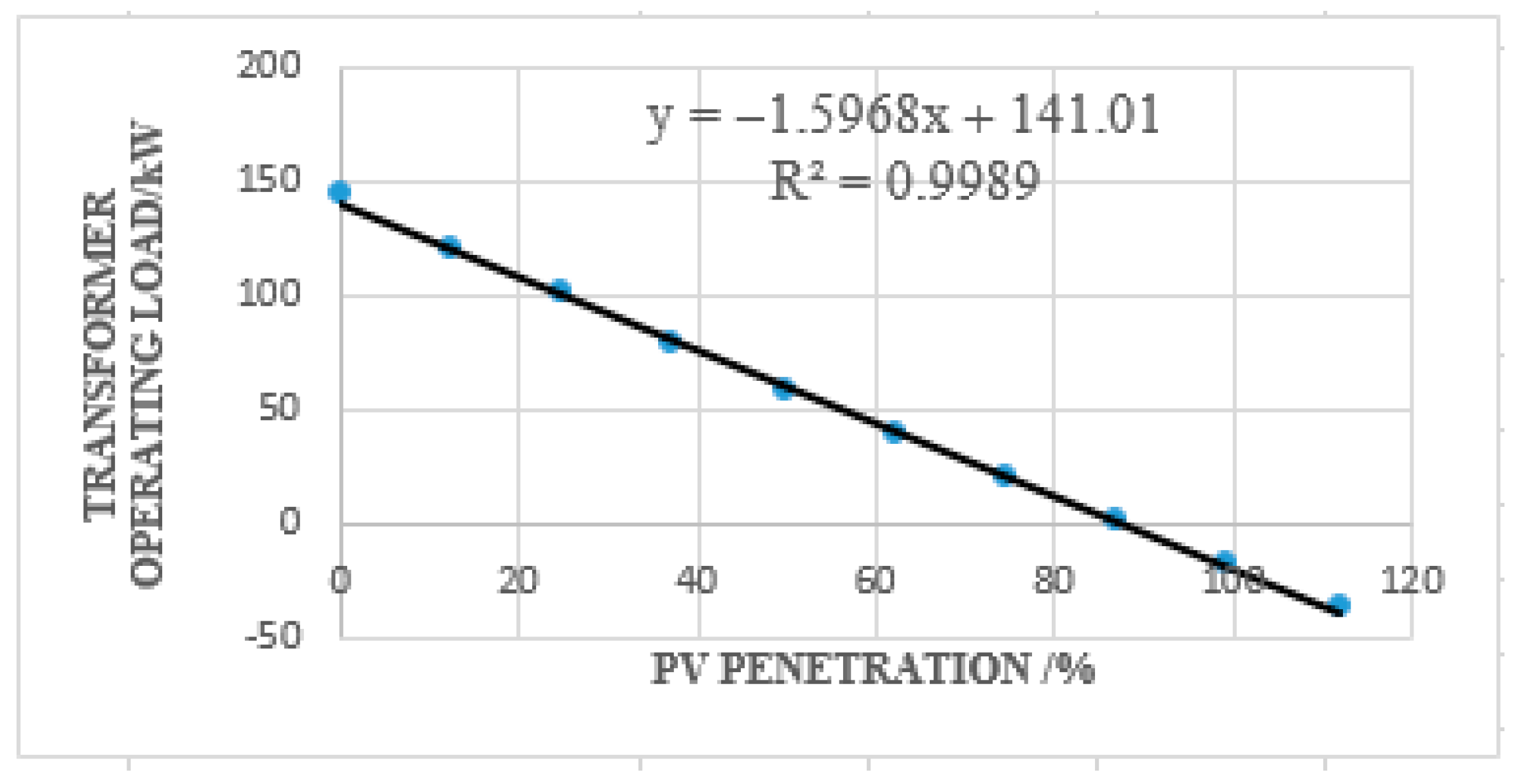

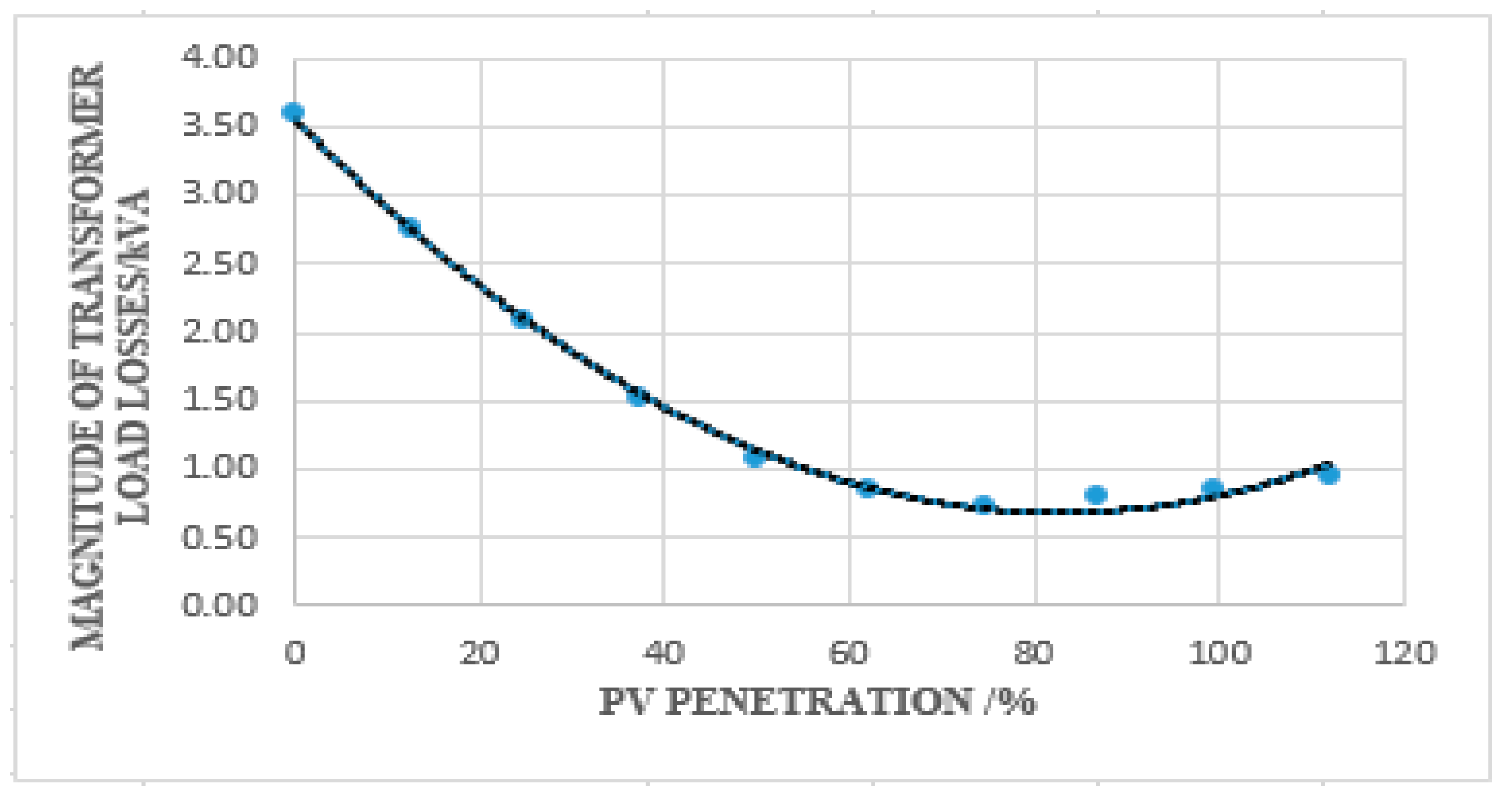
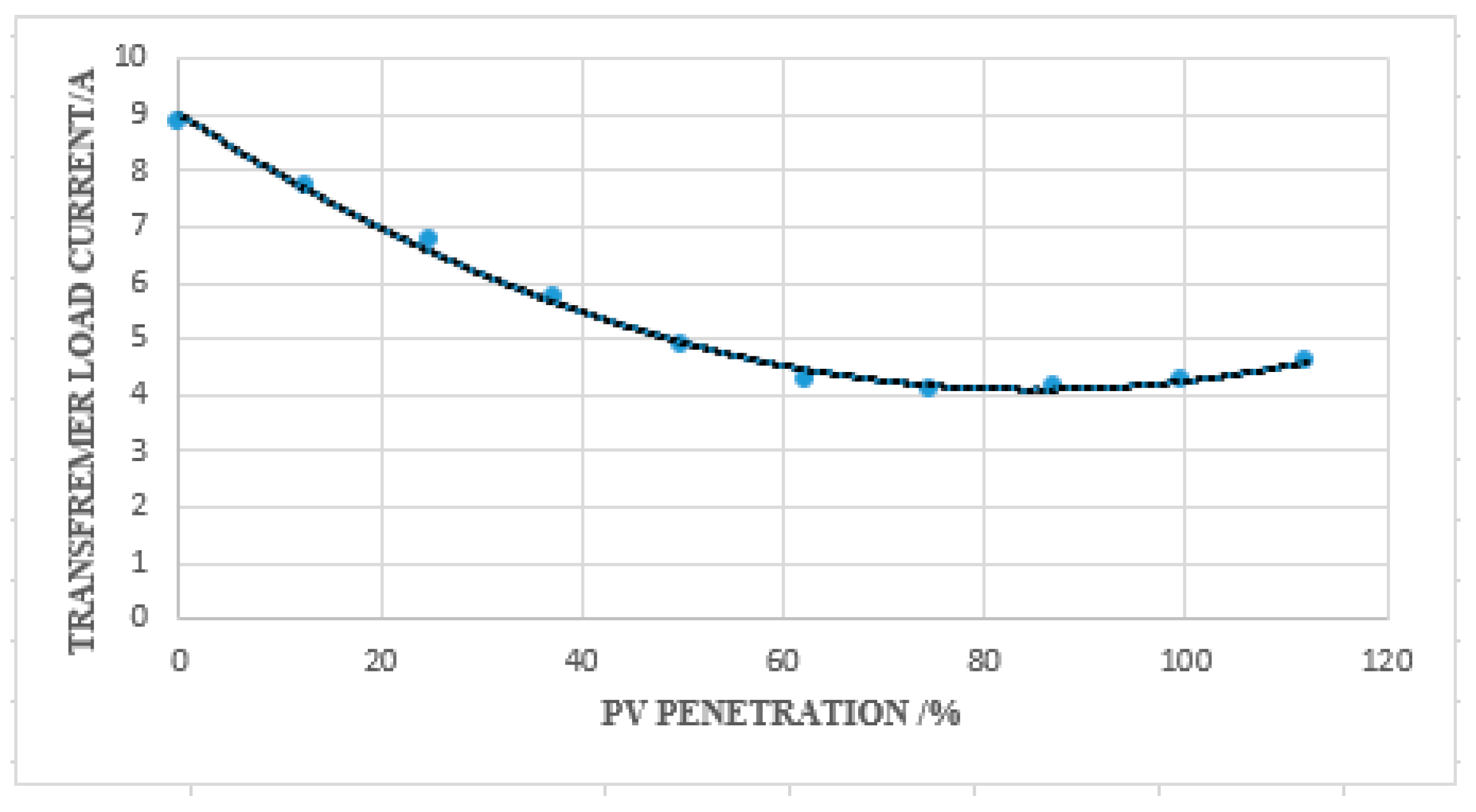
| Parameter | Value | |
|---|---|---|
| Load | Section Id | Lump 76 |
| Load type | Constant kVA = 80% constant Z = 20% | |
| Nominal voltage | 230 V/415 V | |
| Typical Connected load | 1.5 kW | |
| Configuration | Delta | |
| Power factor | 0.85 | |
| Customer type | Residential | |
| Load factor | 0.9 | |
| Load distribution | lumped load, unbalanced | |
| 11 kV Feeder Source | Nominal voltage | 11.5 kV |
| Operating voltage | 11 kV | |
| Base Power | 100 MVA | |
| Short-circuit rating | 31.8 MVA (three-phase) | |
| Source Configuration | Wye |
| Parameter | Value | |
|---|---|---|
| Overhead Line | Equivalent Impedance | Positive sequence |
| Zero sequence, 21 ohms | ||
| Conductor Type | LV, 50 mm2 ACSR | |
| Maximum Span | LV, 50 m | |
| Nominal Ampacity | LV, 209 A | |
| Maximum Temperature | 75 °C | |
| Distribution Transformer Windings | Section Id | C96 |
| Frequency | 50 Hz | |
| Type | Three-phase core | |
| Nominal Rating | 315 kVA | |
| Primary Voltage | 11 kVline | |
| Secondary Voltage | 0.415 kVline | |
| Sequence Impedance | Z1 = 4%, Z0 = 4% | |
| X1/R1 = 1.5%, X0/R0 = 1.5% | ||
| Configuration | Primary, delta | |
| Secondary, star | ||
| Phase Shift | Dyn11 |
| Convergence Criteria Parameter | Value |
|---|---|
| Calculation Method | Adaptive Newton–Raphson |
| Convergence Parameters | 0.0001 tolerance |
| 99 iterations | |
| Calculation Options | Assume line transposition |
| Include line charging |
| PV Panel | |
|---|---|
| Manufacturer | Photowatt |
| Model | PW6-110 |
| Type | Multi-crystalline |
| Size | 110 |
| Number of cells | 36 |
| Maximum Vdc | 1000 |
| Power factor | 1 |
| Watt/Panel | 110.3 |
| Number in series | 20 |
| Number in Parallel | 10 |
| Irradiance/W/m2 | 1000 |
| Ta (Ambient temperature)/degree Celsius | 30 |
| Tc (Cell temperature)/degree Celsius | 5 |
| MPP (Maximum power point)/kW | 21.69 |
| Amps, dc | 64.2 |
| DC Rating | |
|---|---|
| kW | 22.06 |
| V | 343.6 |
| FLA (Full load Ampere) | 64.2 |
| %Efficiency | 90.34 |
| AC rating | |
| kVA | 19.93 |
| kV | 0.415 |
| FLA | 27.73 |
| %PF | 100 |
| Imax | 150% |
| PV Peak Inverter Output/KVA | PV Location with Worst Bus Voltage | PV Penetration/% | Transformer Operating Load/kVA | Transformer Operating Load/KW | Magnitude of Transformer Losses (kVA) | Transformer Operating Current/A |
|---|---|---|---|---|---|---|
| 0 | A6/10 | 0 | 169 | 144.5 | 3.61 | 8.87 |
| 19.93 | A13 | 12 | 147.3 | 121.6 | 2.75 | 7.73 |
| 39.86 | D7/4 | 25 | 128.6 | 101.1 | 2.08 | 6.75 |
| 59.79 | D8/3 | 37 | 109.5 | 79.55 | 1.53 | 5.75 |
| 79.72 | C12 | 50 | 92.73 | 59.04 | 1.08 | 4.87 |
| 99.65 | A7/4 | 62 | 81.76 | 39.57 | 0.86 | 4.29 |
| 119.58 | D6/4 | 75 | 78.31 | 21.08 | 0.72 | 4.11 |
| 139.51 | C6/3 | 87 | 79.14 | 2.13 | 0.81 | 4.15 |
| 159.44 | A1/4 | 99 | 81.3 | −16.42 | 0.86 | 4.27 |
| 179.37 | - | 112 | 87.5 | −35.51 | 0.94 | 4.59 |
| Transformer Loading Limits | PV Penetration/% | Transformer Operating Load/kVA | Transformer Operating Load/% | Transformer Operating Load/kW | Transformer Net Operating Load/A | Transformer Load Losses/kW |
|---|---|---|---|---|---|---|
| Without PV Injection | 0 | 315.1 | 100 | 265 | 16.54 | 6.99 |
| With PV Injection | 88.30 | 78.04 | 24.77 | 0 | 4.28 | 0.55 |
Publisher’s Note: MDPI stays neutral with regard to jurisdictional claims in published maps and institutional affiliations. |
© 2022 by the authors. Licensee MDPI, Basel, Switzerland. This article is an open access article distributed under the terms and conditions of the Creative Commons Attribution (CC BY) license (https://creativecommons.org/licenses/by/4.0/).
Share and Cite
Majeed, I.B.; Nwulu, N.I. Impact of Reverse Power Flow on Distributed Transformers in a Solar-Photovoltaic-Integrated Low-Voltage Network. Energies 2022, 15, 9238. https://doi.org/10.3390/en15239238
Majeed IB, Nwulu NI. Impact of Reverse Power Flow on Distributed Transformers in a Solar-Photovoltaic-Integrated Low-Voltage Network. Energies. 2022; 15(23):9238. https://doi.org/10.3390/en15239238
Chicago/Turabian StyleMajeed, Issah Babatunde, and Nnamdi I. Nwulu. 2022. "Impact of Reverse Power Flow on Distributed Transformers in a Solar-Photovoltaic-Integrated Low-Voltage Network" Energies 15, no. 23: 9238. https://doi.org/10.3390/en15239238
APA StyleMajeed, I. B., & Nwulu, N. I. (2022). Impact of Reverse Power Flow on Distributed Transformers in a Solar-Photovoltaic-Integrated Low-Voltage Network. Energies, 15(23), 9238. https://doi.org/10.3390/en15239238







